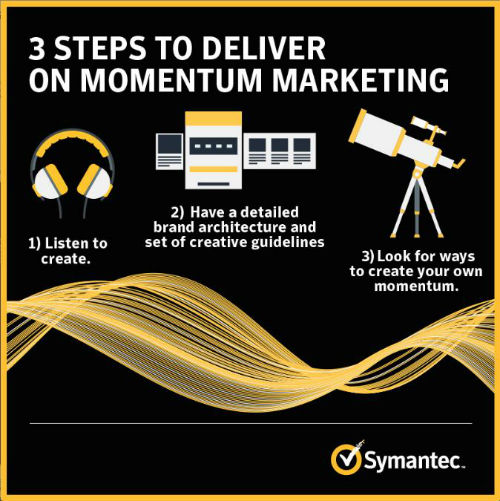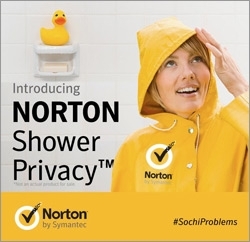
Creating demand with content that is relevant to your target audience in real-time is both a challenge and an opportunity for digital marketers. But that is exactly what Alix Hart, Acting CMO at Symantec, is doing with what she calls “Momentum Marketing”.
This post is a liveblog of a presentation Alix gave today on building Marketing Momentum at a MIMA event in Minneapolis.
The official description: As digital expands into every facet of a consumer’s life, marketing strategy and brand storytelling must shift its focus to create content driven by consumer conversations and needs. So how do brands get there? How can a brand leverage the momentum of conversations consumers are already having? Alix and her team at Symantec are taking a new approach to deliver useful and relevant information relating to what consumers are already seeking out. Join us to hear her three-step plan to capitalize on what she calls “momentum marketing”, and find out what’s next in the space.
But first, who is Alix Hart? @trahla
Alix leads branding, integrated marketing, content and storytelling, digital marketing, and media at Symantec. Symantec protects information and identities for people, businesses and governments through leading security technologies, services, and software. Symantec operates one of the largest global data-intelligence networks and provides leading security, backup and availability solutions under the Symantec, Veritas, and Norton brands, including the market-leading Norton Security software.
Here are the “Cliff Notes” on how to employ Momentum Marketing from Alix herself:
1) Listen to create. Everyone has access to social and search insights. Use them.Have a communications loop with your ad agencies and other marketing teams to let it drive decision-making and the creative process. The faster that loop, the faster you can ride that momentum to deliver a relevant brand message.
2) Have a detailed brand architecture and set of creative guidelines. Have a clear creative strategy with malleable guidelines so that social and content marketing teams can have the flexibility to work from the same strategy but mold the right content in real time. Social marketers need air cover to try ideas, empowered with the right creative guidelines and editorial voice for the brand.
3) Look for ways to create your own momentum. Once you know what types of conversations yield the most affinity and relevancy for your brand, look for ways to create new content that sparks a moment for your brand.

Now for the deep dive based on the presentation at MIMA: To make sense of Momentum Marketing for your digital marketing programs, think of it this way: Momentum Marketing is creating content to answer customer questions in real-time. It means using social listening to identify those customer questions and then create a diverse mix of content and media to answer them. To reach target audiences, it also means tapping into a mix of owned, earned and paid media for exposure. Then measure performance for exposure, consumption and optimization opportunities.

How Momentum Marketing has evolved at Symantec:
Most consumers are familiar with Symantec or at least Norton as a source of security solutions. There are over 200 million Norton and SEP consumers.
Part of the brand promise for Symantec is the ability to see threats. 2014 was the “year of the breach” (Target, Sony, J.P. Morgan, Apple, etc). All the security breaches in the news became a wake-up call. The issue of security extended beyond IT to interest in security solutions from business executives. That growing interest from the C-suite spelled an opportunity for Symantec.
The year of the breach was a moment of truth for Symantec to answer consumer questions: “Am I at risk too”?
Marketing steps to implement a momentum marketing approach:
- Social listening, empowered marketers, nimble creative
- Editorial newsroom
- Paid, owned, earned – promotion
All three of these steps lead to greater brand affinity for Symantec as a thought leader in the field of security solutions.
First step is to listen, ideate and create. Symantec employs a listening team that monitors keywords related to the conversations they want to be a part of.
Brand campaign: Boldly Go – Meet the New Norton

Norton created the campaign in a way that supported customization for different markets and applications. Adaptability of brand assets is essential for this kind of customization. (At TopRank Marketing we call this “Modular Content”).
The second step was to create an editorial newsroom. To lead this effort, Symantec hired a former TV producer/reporter.
For newsrooms to work well, it’s important to be responsive, agile and real-time. News cycles operate on a 24 hour cycle so it’s essential to be ready to respond and act.
Steps for brand involvement in a news cycle:
- Breaking news
- Begin publishing brand content
- Journalists scramble for additional information
- Public excitement
- Story peaks
- Story becomes old news
To be responsive, Symantec had to rethink their process:
- Set a cadence for the newsroom to be more real time
- Cast a wide net of internal stakeholders
- Know your go-to content strategists internally
- Flex up and down in the organization with resources to adapt to content needs
- Create a content repository (including video). Beyond production, get the content to all the right people, including consideration of translation
- “Follow the Sun” – Development and communications
An example of Symantec employing “Momentum Marketing” was the Olympics in Sochi. Even taking a humorous approach: #SochiProblems

The third step for Momentum Marketing at Symantec was to used Forbes BrandVoice native advertising as a hub for promoting content.
Overall next steps for Symantec is to create their own momentum and hub. They’re creating a lot of demand but customer segments, buying cycle are not defined or aligned with this content. Implementing more focused lead generation activities with momentum marketing programs are in the plans for next steps.
How to create your own momentum:
- Define where your brand can have relevant moments of intersection
- Leverage social insights (search too) to understand customer conversations
- Create a communications process map – who is playing what role
- Empower your teams to try, test and measure – be free to experiment
- Use all media – paid, owned, earned. Think of all the formats to bring your message to life
Of course there was a Q and A at the end with many smart questions from the MIMA audience. I finished this post instead of covering them but I think you catch many of them through the event hashtag, #mimatweet.



